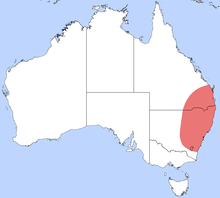Myrmecia gulosa
| Myrmecia gulosa | |
|---|---|
| Scientific classification | |
| Domain: | Eukaryota |
| Kingdom: | Animalia |
| Phylum: | Arthropoda |
| Class: | Insecta |
| Order: | Hymenoptera |
| Family: | Formicidae |
| Subfamily: | Myrmeciinae |
| Genus: | Myrmecia |
| Species: | M. gulosa
|
| Binomial name | |
| Myrmecia gulosa (Fabricius, 1775)
| |

| |
Myrmecia gulosa, the red bull ant,
Taxonomy
The first Myrmecia gulosa specimen was collected in 1770 by Joseph Banks, making it one of the first Australian insects to be collected and described by a European.
Description
Being one of the larger ant species, adult individuals have been observed to be as long as 15 mm to 30 mm in body length. The head and
Distribution and habitat
Myrmecia gulosa ants are abundant in eastern Australia. They can be found in the coastal regions of
Their distribution in
Behaviour
Regarded as a relatively "primitive" ant species, red bull ants are known to be solitary predators that are occasionally uncooperative with one another, whose social behaviour is poorly developed in comparison to more "advanced" species. They are notoriously aggressive hunters able to subdue formidable prey such as
Nests are constructed with tunnel systems and may become quite extensive.
References
- doi:10.1080/00222939100771021. Archived from the original(PDF) on 30 May 2009. Retrieved 2 December 2014.
- ^ Clark, John; CSIRO (1951), The formicidae of Australia. Volume 1, Subfamily Myrmeciina (PDF), Melbourne: Commonwealth Scientific and Industrial Research Organisation, Australia, pp. 49–51, retrieved 2 December 2014
- CSIRO. 19 September 2004. Retrieved 7 December 2014.
- ^ "Species: Myrmecia gulosa (Fabricius, 1775)". AntWeb (California Academy of Sciences). Retrieved 2 December 2014.
- ISBN 0-642-21422-0. Retrieved 2 December 2014.)
{{cite book}}: CS1 maint: multiple names: authors list (link
External links
- "Myrmecia gulosa". Integrated Taxonomic Information System. Retrieved 20 April 2007.
- "Red Bull Ant - Myrmecia gulosa". 2006-09-26. Archived from the original on 2006-11-13. Retrieved 2007-04-20.
- Moffett, Mark W. (May 2007). "Lone Huntress: The Bulldog Ant". ISSN 0027-9358. Archived from the originalon May 14, 2007.
- "Bull Ants Fact File". Australian Museum. Archived from the original on 2007-05-17. Retrieved 2007-04-20.
{{cite journal}}: Cite journal requires|journal=(help)
External images
 Media related to Myrmecia gulosa at Wikimedia Commons
Media related to Myrmecia gulosa at Wikimedia Commons- Myrmecia gulosa - Antweb
